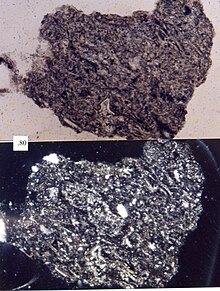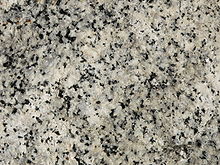Felsic
The word "felsic" is a term used in geology to refer to silicate minerals, magma, and igneous rocks which are enriched in the lighter elements such as silicon, oxygen, aluminium, sodium, and potassium.



They are usually light in colour and have specific gravities less than 3. The most common felsic rock is granite, but others include quartz, muscovite, orthoclase, and the sodium-rich plagioclase feldspars. In terms of chemistry, felsic rocks are on the other side of the rock spectrum from the mafic rocks.
Classification of felsic rocks
changeIn order for a rock to be classified as felsic, it generally needs to contain more than 75% felsic minerals; namely quartz, orthoclase and plagioclase. Rocks with greater than 90% felsic minerals can also be called leucocratic, meaning 'light-coloured'.
The rock texture thus determines the basic name of a felsic rock.
| Rock Texture | Name of Felsic Rock |
| Pegmatitic | Granite pegmatite |
| Coarse-grained (phaneritic) | Granite |
| Coarse-grained and porphyritic | Porphyritic granite |
| Fine-grained (aphanitic) | Rhyolite |
| Fine-grained and porphyritic | Porphyritic rhyolite |
| Pyroclastic | Rhyolitic tuff or breccia |
| Vesicular | Pumice |
| Amygdaloidal | None |
| Vitreous | Obsidian or porcellanite |
References
change- Le Maitre L.E. (ed) 2002. Igneous rocks: a classification and glossary of terms'. 2nd ed, Cambridge University Press.